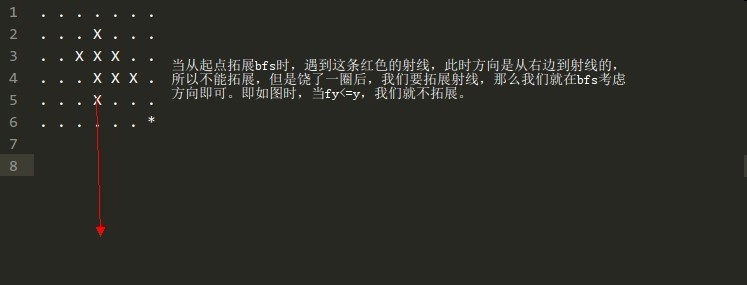http://www.lydsy.com/JudgeOnline/problem.php?id=1656
神bfs!
我们知道,我们要绕这个联通的树林一圈。
那么,我们想,怎么才能让我们的bfs绕一个圈做bfs呢
我们可以这样:从联通的任意边界点引一条交边界的射线。
为什么呢?因为这样当我们的bfs到这条射线时,我们可以不向射线拓展!
可是我们考虑的是绕一个圈,那么我们要考虑从另一个放向到达射线的情况(即饶了一圈后到射线我们要考虑拓展)

这样我们就能保证绕了联通块一圈,然后是最短距离
具体细节看代码
#include <cstdio>
#include <cstring>
#include <cmath>
#include <string>
#include <iostream>
#include <algorithm>
#include <queue>
using namespace std;
#define rep(i, n) for(int i=0; i<(n); ++i)
#define for1(i,a,n) for(int i=(a);i<=(n);++i)
#define for2(i,a,n) for(int i=(a);i<(n);++i)
#define for3(i,a,n) for(int i=(a);i>=(n);--i)
#define for4(i,a,n) for(int i=(a);i>(n);--i)
#define CC(i,a) memset(i,a,sizeof(i))
#define read(a) a=getint()
#define print(a) printf("%d", a)
#define dbg(x) cout << #x << " = " << x << endl
#define printarr2(a, b, c) for1(i, 1, b) { for1(j, 1, c) cout << a[i][j] << ' '; cout << endl; }
#define printarr1(a, b) for1(i, 1, b) cout << a[i] << ' '; cout << endl
inline const int getint() { int r=0, k=1; char c=getchar(); for(; c<'0'||c>'9'; c=getchar()) if(c=='-') k=-1; for(; c>='0'&&c<='9'; c=getchar()) r=r*10+c-'0'; return k*r; }
inline const int max(const int &a, const int &b) { return a>b?a:b; }
inline const int min(const int &a, const int &b) { return a<b?a:b; }
const int N=60, Q=N*N*10, dx[]={-1, 1, 0, 0, -1, 1, -1, 1}, dy[]={0, 0, -1, 1, -1, -1, 1, 1};
int a[N][N], line[N][N], f[2][N][N], n, m, front, tail, flag, x, y, X, Y;
struct dat { int x, y, f; }q[Q];
int main() {
read(n); read(m);
for1(i, 1, n) for1(j, 1, m) {
char ch=getchar(); while(ch!='.'&&ch!='X'&&ch!='*') ch=getchar();
if(ch=='X') a[i][j]=1, x=i, y=j;
else if(ch=='*') X=i, Y=j;
}
for1(i, 1, n) if(i+x<=n) line[i+x][y]=1; else break;
q[tail].x=X, q[tail].y=Y, q[tail++].f=0;
while(front!=tail) {
dat &t=q[front++]; if(front==Q) front=0;
x=t.x, y=t.y, flag=t.f;
rep(i, 8) {
int fx=dx[i]+x, fy=dy[i]+y;
if(fx<0 || fy<0 || fx>n || fy>m || a[fx][fy]) continue;
if((line[x][y] || line[fx][fy]) && fy<=y) continue; //当前在射线上或下一个点是射线上时(即从右向左),不能向左拓展
if(line[fx][fy] && !f[1][fx][fy]) { //当这是从射线左边向射线过来时,更新上的点
f[1][fx][fy]=f[flag][x][y]+1;
q[tail].x=fx, q[tail].y=fy, q[tail++].f=1; if(tail==Q) tail=0;
}
else if(!f[flag][fx][fy]) { //继承饶了一圈后的距离向四周拓展
f[flag][fx][fy]=f[flag][x][y]+1;
q[tail].x=fx, q[tail].y=fy, q[tail++].f=flag; if(tail==Q) tail=0;
}
}
}
print(f[1][X][Y]);
return 0;
}
Description
The pasture contains a small, contiguous grove of trees that has no 'holes' in the middle of the it. Bessie wonders: how far is it to walk around that grove and get back to my starting position? She's just sure there is a way to do it by going from her start location to successive locations by walking horizontally, vertically, or diagonally and counting each move as a single step. Just looking at it, she doesn't think you could pass 'through' the grove on a tricky diagonal. Your job is to calculate the minimum number of steps she must take. Happily, Bessie lives on a simple world where the pasture is represented by a grid with R rows and C columns (1 <= R <= 50, 1 <= C <= 50). Here's a typical example where '.' is pasture (which Bessie may traverse), 'X' is the grove of trees, '*' represents Bessie's start and end position, and '+' marks one shortest path she can walk to circumnavigate the grove (i.e., the answer): ...+... ..+X+.. .+XXX+. ..+XXX+ ..+X..+ ...+++* The path shown is not the only possible shortest path; Bessie might have taken a diagonal step from her start position and achieved a similar length solution. Bessie is happy that she's starting 'outside' the grove instead of in a sort of 'harbor' that could complicate finding the best path.

Input
* Line 1: Two space-separated integers: R and C
* Lines 2..R+1: Line i+1 describes row i with C characters (with no spaces between them).
Output
* Line 1: The single line contains a single integer which is the smallest number of steps required to circumnavigate the grove.
Sample Input
.......
...X...
..XXX..
...XXX.
...X...
......*